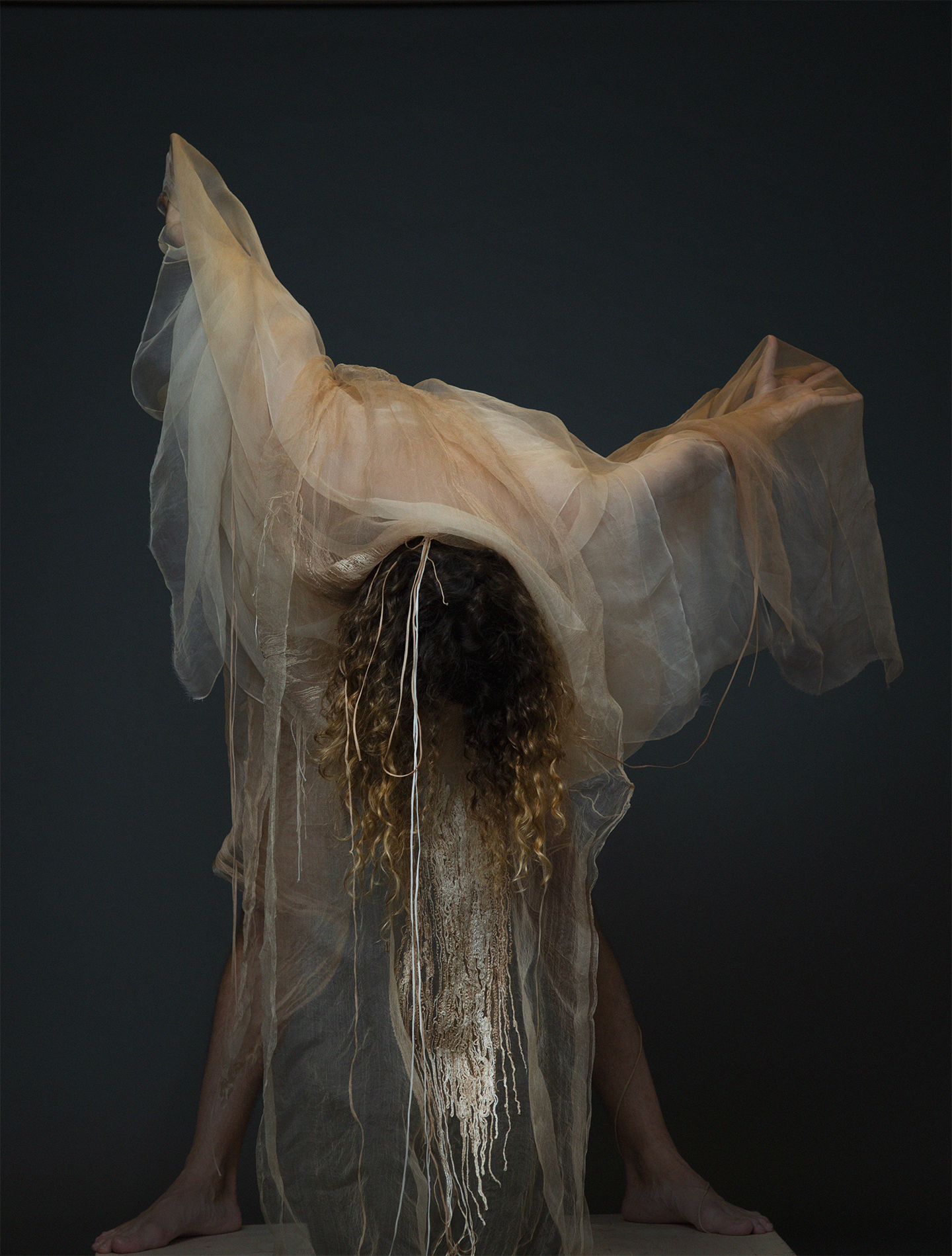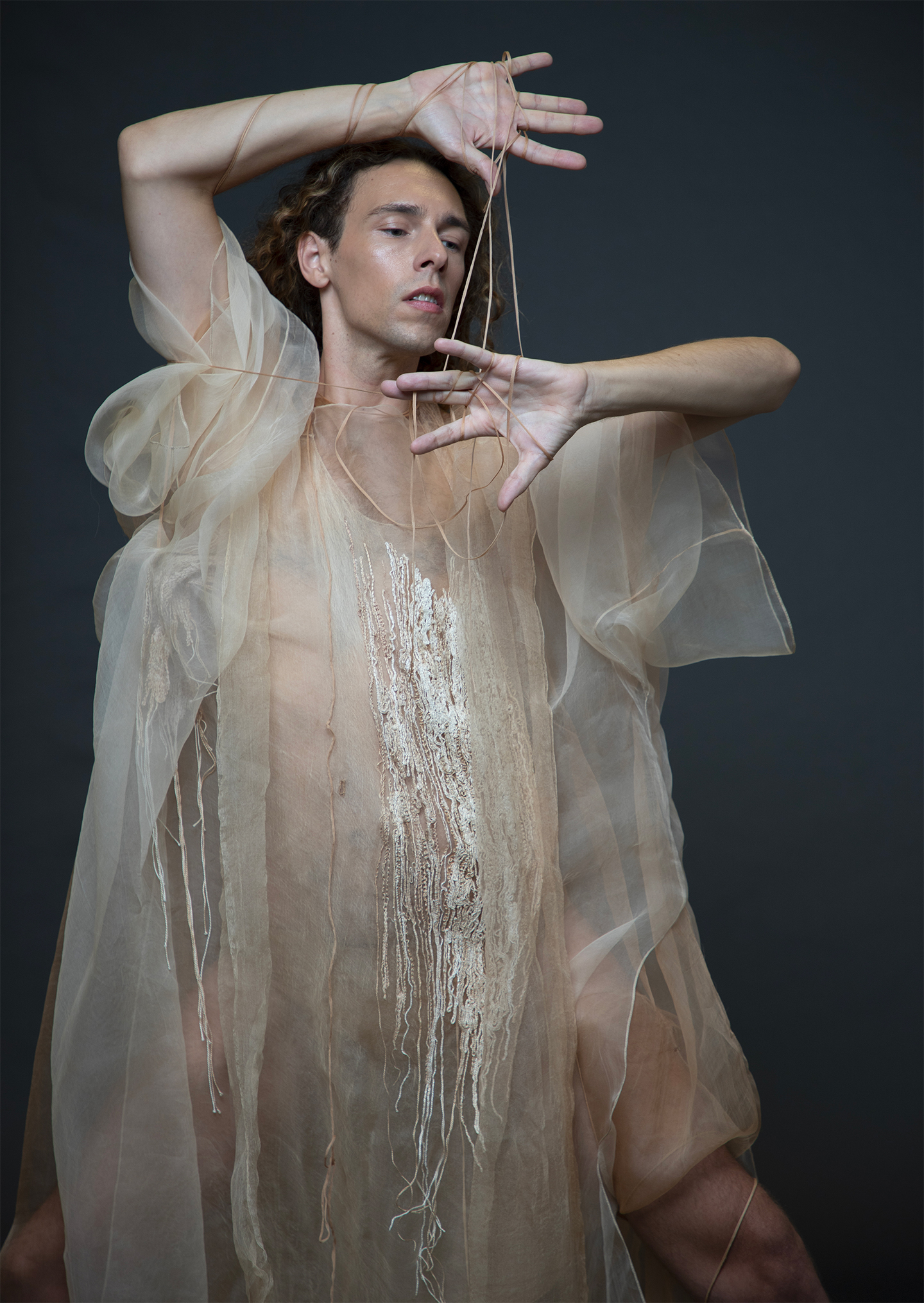

An established textile designer, researcher and valued member of the Istituto Marangoni Department of Fashion and Textiles, Karen Spurgin, is one half of a research partnership (the other being MA Fashion Programme Leader Kirsten Scott) that has sought sustainable solutions to fashion’s never-ending demand for the “new” in east African plants and ancient textile manufacture.

Bark being stripped from a Ugandan Mutuba tree. Photography: Kirsten Scott
Forming long-term partnerships with rural Ugandan communities, the pair have been assessing an ancient non-woven textile called bark cloth and its suitability for the luxury market in terms of environmental impact, plus its haptic and aesthetic properties.
In this article, Karen Spurgin describes her research process when addressing bark cloth and one of its by-products, natural dye created from bark cloth off-cuts. She then goes on to explain her practice in embroidery, using thread and silk fabric, both dyed with bark cloth extract.
The pictures below feature Spurgin’s work, interpreted in a performance by fellow Istituto Marangoni London tutor Matteo Augello.
Minding how we dye
Being mindful of the impact of textiles within the fashion system led me to pursue design that addresses environmental concerns and focuses on exploring sustainable solutions.
In 2007, I co-founded ao textiles. Now with a proven track record in sustainability, ao textiles consultancy focuses on research and development to create colour from natural dyes for textile production.
For centuries, plant-based sources were used to create colours for textiles. However, this practice suddenly stopped in the late 19th century when synthetic dyes obtained from petrochemicals started being widely used.

IM tutor Dr. Matteo Augello responds to Karen Spurgin’s bark-dyed embroidery through performance. Photography: IM London’s MA Photo-department
The skin issue
Skin is our largest organ. There is mounting evidence that ubiquitous synthetic fibres, dyes and finishes are not benign.
For example, according to Fibershed, an American NGO that champions the holistic production of natural fires and dyes, synthetic compounds in the textile supply chain, including dyes, often manifest as endocrine disrupters and can be carcinogenic.
More exhaustive studies suggest that prolonged contact with the skin may absorb the chemical load carried in fibres we wear. This emerging topic is feeding into current debates around the synthetic compounds used in textile production.

IM tutor Dr. Matteo Augello responds to Karen Spurgin’s bark-dyed embroidery through performance. Photography: IM London’s MA Photo-department
The great comeback of natural dyes
Preserving heritage, reviving techniques and adapting plant-based colours for contemporary textiles is the subject of much of my ongoing research.
It has particular relevance at this time, contributing to the critical discourse on how we make things and their impact on the environment. This concern has become a primary interest of mine.
Re-examining natural dyes as part of a regenerative agricultural system could give us a better model for 21st-century colours.
Although my background is mainly in surface design, I have shifted my focus to sustainable and practice-based research using natural and sustainable dyes and finishes in conjunction with bark cloth.
This is part of the BCRN-Bark Cloth Research Network project centred in East Africa. This multidisciplinary group of researchers, artists, environmentalists, farmers, and fashion and design practitioners across Uganda, the UK, and the USA have come together to uncover and develop the potential of locally grown Ugandan bark cloth.

IM tutor Dr. Matteo Augello responds to Karen Spurgin’s bark-dyed embroidery through performance. Photography: IM London’s MA Photo-department
A gift from the Mutuba tree
Bark cloth is produced from bark harvested from the Mutuba (Ficus Natalensis) tree. The stripped bark is soaked and beaten with a heavy wooden mallet for several hours, causing the fibres to soften and mesh into a non-woven textile.
The BCRN research recognises the slow, regenerative processes involved in tending the Mutuba tree, harvesting the bark, and making bark cloth. As an indigenous, endangered textile and a part of the Intangible Cultural Heritage of Humanity, its ongoing production is vital, including how it may be used as part of a responsible, luxury fashion system.
BCRN acknowledges working with borrowed cloth and that key research will be returned to the Ugandan community. My investigation into bark cloth centres on surfaces and finishes.

IM tutor Dr. Matteo Augello responds to Karen Spurgin’s bark-dyed embroidery through performance. Photography: IM London’s MA Photo-department
The hidden power of natural colour
With this in mind, I have begun investigating possible sustainable low-tech uses for non-woven textiles that are repeatable and scalable over time. I looked at the potential for natural colour to address the need for a sustainable solution.
Additionally, my work often aims to achieve the goal of zero waste. Knowing that bark cloth is a valuable material, all off-cuts are collected and saved for future use.
When the bark cloth scraps are soaked in water, an extract is produced that can be used to dye different types of fibres and fabrics. The results obtained so far have shown that, when used in conjunction with scoured and mordanted fibres and fabrics, the dye creates a pink/tan colour.
Colour depth can be adjusted by varying the time the textiles are soaked in the dye bath. Initial light tests have shown promising results, especially with protein fibres such as silk and wool.
From dyed textiles to sustainable garments
For this project, I incorporated various elements of my practice, exploring colour and stitching to create a garment that embraces the sustainability mindset and values.
Working with Matteo Augello and the MA Photo-department at Istituto Marangoni London, we explored the interactions between human skin and a naturally dyed textile through Matteo’s performance and fashion photography.

IM tutor Dr. Matteo Augello responds to Karen Spurgin’s bark-dyed embroidery through performance. Photography: IM London’s MA Photo-department
The garment in the picture is made of a combination of unbleached silk crepeline and hand-loomed fair-trade silk organza. The fabric and embroidery threads were dyed with a safe, non-toxic colour from the bark cloth extract.
As a result, the garment has a clear and traceable origin and showcases the potential of environmentally conscious design to become the new standard of luxury.
Karen Spurgin
Director at ao textiles and IM tutor, London


